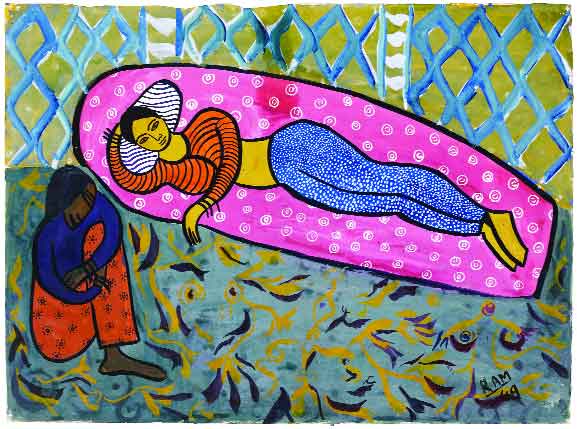Olga Bogroff’s small suite is testament to the genesis of Indian contemporary art in Paris. By Uma Nair
Picture this, artist Ram Kumar arrives in Paris at the end of 1949. He has a few works with him, which were done in India. Among them is a work titled Twins. The price of this gouache on paper is Rs 65. Another is called Why Can’t I Get Sleep, which has a romantic reverie about it as you see a young maiden reclining with a woman who is sitting next to her in companionship, perhaps presiding over the travails of the world. The work belongs to Olga Bogroff, a gallery persona in Paris, who used her home as a gallery for young unknown artists. It was called Galerie Olga Bogroff and these works today form Grosvenor’s stunning South Asian Modern Art exhibition.
Romancing the figurative
Kumar’s works are a reflection of an early romance with the figurative and a study on female studies that unravel like jewels from the yesteryear. Twins and Why Can’t I Get Sleep are two succinct works steeped in history. This is perhaps the best time to go back in 1993 to Ram Kumar’s words as he recalled, “Perhaps every artist starts with the figurative because when we go to an art school, there is a model and we have to do drawings, learn anatomy and all that. So perhaps it is a very natural thing, along with landscape, at least for me. The reason I made these sort of paintings, was that I was a bit inspired by the left politics at that time and I was inclined towards the tragic side of life. It all started here, becoming more mature in Paris. And even if I had not been inspired by politics, perhaps I would have made the same kind of paintings because that is a part of my nature some sort of sadness, misery or whatever it is. Also my short stories are always towards people who have suffered.”
Modern women
Twins has two female figures, their saris billowing in the breeze, while Why Can’t I Get Sleep has a reclining young woman with a bare midriff, eyes wide open resting in leisure while another sits next to her. The division of the space into a grill and the foreground textured with small strokes speaks of both simplicity and sophistication. In this composition, Kumar creates a tableau vivant. This painting combines the realism and cultural symbolism of a social construct with the contrast of two complexions — the bronze skin and the fair toned lass, who is unable to get sleep. Indeed it also reflects a romantic dalliance in the features that Kumar created with a softness and feminine aura that sparks hope, and the subtle play of pensive poise.
The third figurative is another head turner from 1949. Sorrow has a number of women with the elongated dark faces and hollow eyes. The drapes on these women are indeed a testimony to modernism and the beauty of weaving in a language that was ahead of its time. Even when he created figurative, Kumar had a deep understanding of fluid lines, fervour and creating an expression in his triangular faces that was unique to its time and place. Kumar was acutely aware of his urban surroundings and the sense of togetherness in sorrow is the mood that he binds in this historic image. It is an insight to both technique and treatment. In this image of women in sorrow, Kumar treats the feminine figures with a sombre tenderness, invoking the idioms of both sympathy and sorrow. It is the mood of the gathering and the grace in sadness that transcend their own circumstances.
While looking at these epic early works one recalls the words of India’s greatest abstract guru, the thinker, the critic and the genius J Swaminathan when he wrote in an essay on Trends in Indian Modernism, for the Lalit Kala Contemporary published in 1995.
“Ram Kumar, an artist born and brought up in the atmosphere of the city middle class, looking into the empty souls of people ground down by the gruelling run of the daily mill, looking into eyes that have lost their animation, eyes that are windows opening into nothingness, is again a painter who has relied on his personal vision for his artistic endeavors, sad drooping figures, rendered with childlike directness, lingering like shadows in gloomy surroundings of gaunt and empty streets and houses.”
And then there is the brilliant observation of Shyam Lal who wrote, “As a young artist, Ram Kumar was captivated by or rather obsessed with the human face because of the ease and intensity with which it registers the drama of life. The sad, desperate, lonely, hopeless or lost faces which fill the canvases of his early period render with pathos his view of the human condition.” This small suite belonging to Olga Bogroff is the stuff of history, the testament of Indian contemporary art’s genesis in Paris and the connection of great French ambassadors and diplomats who played such a seminal game in the growth of Contemporary Indian art’s masters The Progressives.


























